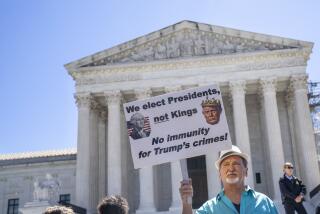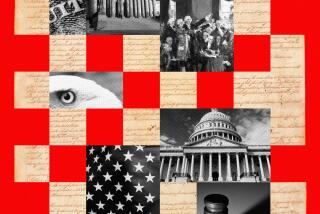What we, the people, want
The holiday we observe today is a flag-waving celebration of the uniquely American values that have endured since Colonial times. First and foremost of these is liberty, which for the founders meant being liberated not only from the tyranny of King George III but from the oppressive hand of any ruler. It was one of the inalienable rights they asserted in the Declaration of Independence, and it remains a beacon that draws people from other nations to these shores.
Yet the founders also recognized that some problems were too big to be solved by individuals on their own terms. The people had to band together to raise an army, establish a federal government and create a currency, among other institutions. These demands left many individuals — such as those conscripted from state militias into the Continental Army, charged excise taxes on sugar or forced to pay tariffs on imported wool — less free to live their lives as they pleased. But the benefits to the society to which they belonged outweighed the costs.
And so it has been throughout this nation’s history. There has always been a tension between individual liberties and the goals and obligations that we, the people, share. Collectively, we took land for railroads, parks and highways. Our elected representatives enacted laws to stop businesses from expanding into monopolies, to limit what we threw into the air and water, and to transfer wealth from workers to retirees and from rich to poor.
PHOTOS: Celebrating Independence Day
We did all these things to solve problems that defied solution by an unfettered market or by individuals, however well-meaning, acting alone. Sometimes states took the lead. Sometimes the vast scale of the task demanded that Washington get involved. And sometimes the only fair approach was one that imposed the same rules and limits on every American. But these decisions were often contested, and bitterly so, by those whose sails were trimmed. As the federal budget grew from less than 3% of the U.S. economy in the 1900s to nearly 20% in the 1960s, the clashes between Republicans and Democrats over when and how to curtail liberty for the common good grew more frequent and intense.
Those fights define Washington today. Prodded by libertarian-oriented tea party groups, Republicans have sought to elevate individual responsibilities over shared ones. They have rejected the idea that the federal government should spend more to make up for a weak private economy, arguing instead that the mounting federal debt is holding back the economy. And rather than trying to mobilize the nation to take on some high-profile problems, such as climate change and an increasingly unaffordable healthcare system, they have essentially argued that the problems don’t exist.
Democrats, meanwhile, sometimes forget how much this country values liberty — except on social issues such as gay marriage and abortion, when they trade places with the GOP as the defenders of personal freedoms. They have repeatedly sought to replace individuals’ choices with the government’s judgments, particularly when it comes to how much risk people should be allowed to take in their businesses, their personal finances and their health.
The 2010 healthcare reform law reflects that mentality. The measure tries to remodel the insurance system so that it spreads costs broadly across the population, rather than denying coverage to many who might actually need medical care. Yet it limits the choice individuals have over how much coverage to carry, eliminating some riskier but less-expensive options. As a result, healthier people may decide to go without insurance and pay a (more affordable) penalty, leaving insurers to cover mainly the sickest, costliest individuals.
That would be disastrous. But the more market-oriented plan floated by Republicans would have encouraged insurers to home in even more aggressively on healthy customers, leaving the sicker and risker ones to seek coverage through state insurance programs whose costs were sure to skyrocket. Worse, according to the Congressional Budget Office, the GOP plan wouldn’t have extended coverage to a higher percentage of the populace, nor would it have done as much to slow the growth of overall healthcare spending.
The philosophical split between the parties is hard to reconcile, even if lawmakers were inclined to compromise. Many are not, reflecting the political realities of gerrymandered congressional districts that are either intensely red or intensely blue. And so Congress has moved from one knotty situation to the next, flirting with grand bargains — and fiscal disasters — before settling on a temporary fix that merely delays the fight for another day.
Eventually, though, the two parties will have to find a way to confront a series of daunting problems, balancing the need to preserve individual liberty against the burdens imposed by the solutions. Climate change is one such issue. Others include an educational system that’s inadequate to meet the demands of the global marketplace, an increasingly serious gap between workers’ skills and the needs of the contemporary economy, and crucial infrastructure weakened by years of neglect. Those come on top of long-term fiscal problems driven by rising healthcare costs and an aging population that’s leaving a dwindling percentage of working adults paying into the Treasury, while a growing percentage of retirees draws benefits out.
History suggests that we will meet the challenges that arise, although progress will no doubt be fitful. The key is for lawmakers to sustain the equilibrium that the founders struck. Fierce advocates of personal liberty must acknowledge the occasional need for collective action, just as ardent believers in a compassionate and activist government must appreciate the power of individual freedom and responsibility. The sooner the current generation of lawmakers recognizes these truths, the sooner they will start accomplishing something.
More to Read
A cure for the common opinion
Get thought-provoking perspectives with our weekly newsletter.
You may occasionally receive promotional content from the Los Angeles Times.










